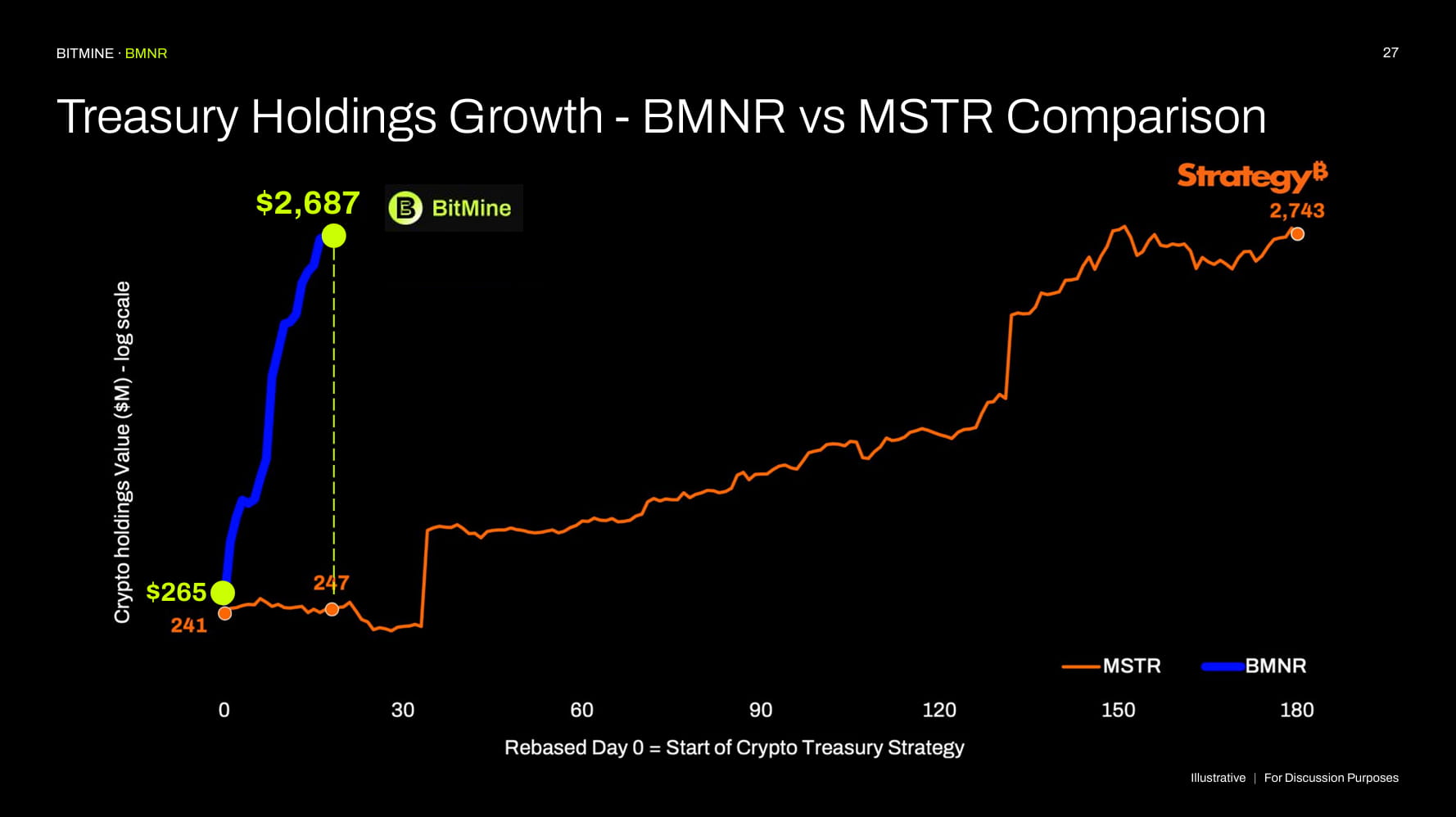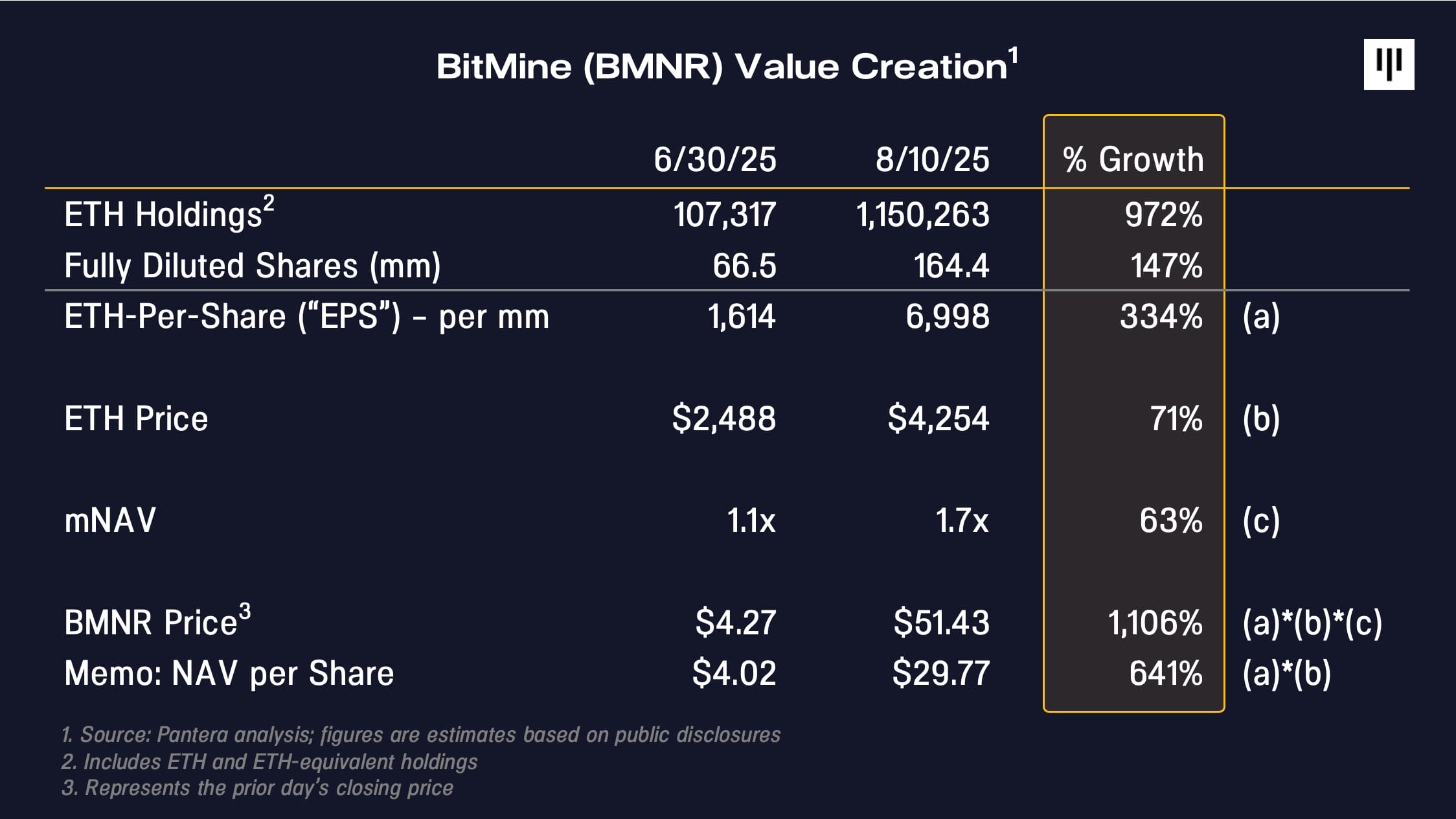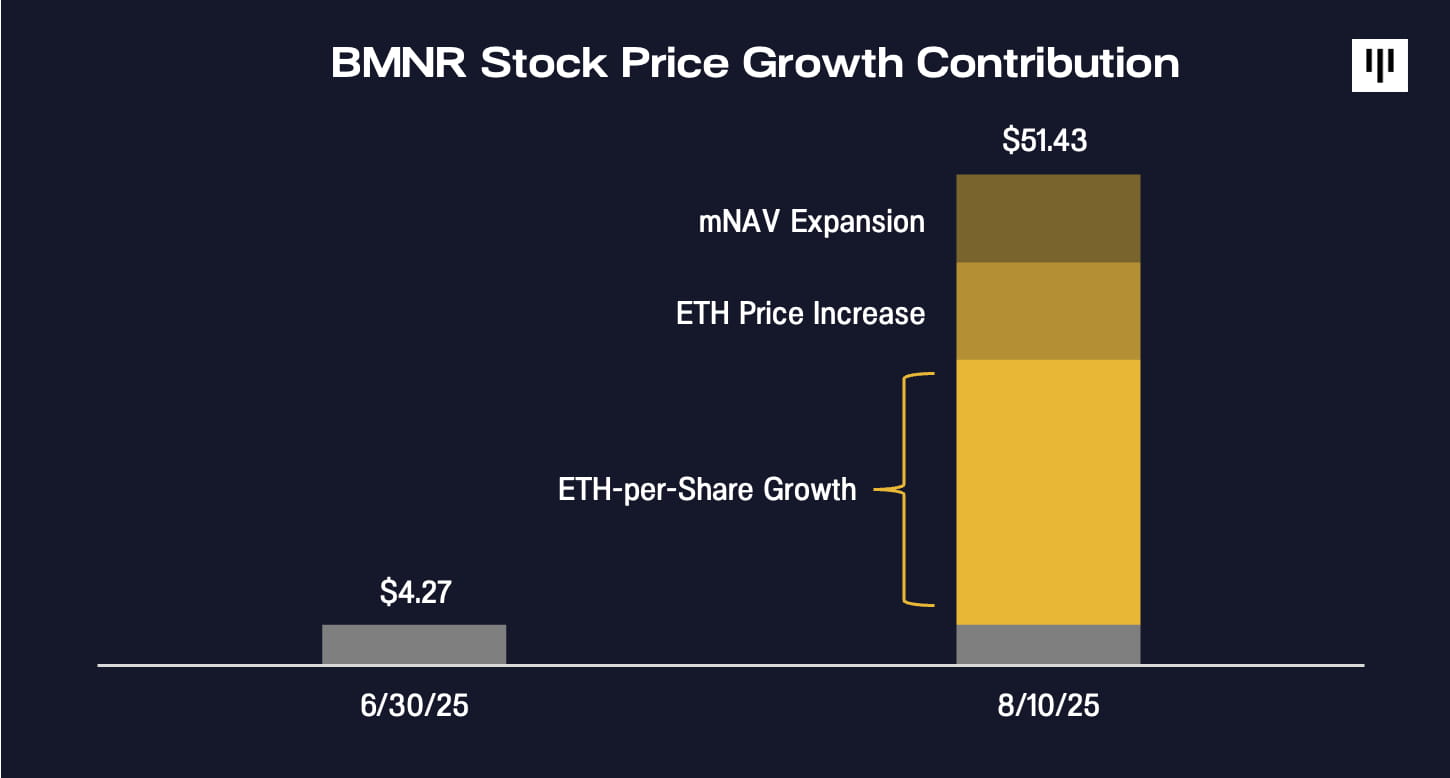Authors: Cosmo Jiang, Erik Lowe
Translated by: Deep Tide TechFlow
Our investment theory on Digital Asset Treasury companies (DATs) is based on a simple assumption:
DATs can increase per-share net asset value by generating income, thereby accumulating more token holdings over time, rather than just holding spot positions.
Therefore, investing in DATs has the potential to yield higher returns compared to directly holding tokens or holding tokens through exchange-traded funds (ETFs).
Pantera has invested over $300 million in various tokens and regions of Digital Asset Treasuries (DATs). These DATs leverage their unique advantages to expand their digital asset holdings through strategic operations that appreciate per share. Below is a brief overview of our DAT portfolio coverage.

BitMine Immersion (BMNR) is the first investment of the Pantera DAT Fund, showcasing a model of a company with a clear strategic plan and execution ability. Fundstrat's Chairman Tom Lee elaborated on BitMine's long-term vision—to acquire 5% of the total ETH supply, a goal referred to as the '5% Alchemy.' We believe it is very meaningful to interpret how an efficiently operating Digital Asset Treasury (DAT) creates value through the case of BMNR.
BitMine (BMNR) Case Study
Since BitMine launched its fund management strategy, it has become the world's largest ETH fund management institution and the third largest DAT (after Strategy and XXI). As of August 10, 2025, BMNR holds a total of 1,150,263 ETH, valued at $4.9 billion. Additionally, BMNR is ranked 25th in U.S. liquidity among stocks, with an average daily trading volume of $2.2 billion (based on the five-day average trading volume as of August 8, 2025).
Ethereum Case Study
The most important factor for the success of DATs lies in the long-term investment value of their underlying tokens. BitMine's DAT strategy is based on a core argument: as Wall Street shifts on-chain, Ethereum will become one of the largest macro trends in the next decade. As we wrote in last month's article, 'The Great Onchain Migration' is underway, with the importance of tokenization innovation and stablecoins becoming increasingly evident.
Currently, there are $25 billion of real-world assets existing on public blockchains—additionally, there are $260 billion in stablecoins, which together have become the 17th largest holder of U.S. Treasury bonds.
"Stablecoins have become the ChatGPT story in the crypto space."
– Tom Lee, Chairman of BitMine, Pantera DAT Call, July 2, 2025
Most of these activities occur on Ethereum, which positions ETH to benefit from the growing demand for blockchain space. As financial institutions increasingly rely on Ethereum's security to support their operations, they will be incentivized to participate in Ethereum’s Proof-of-Stake network—further driving demand for ETH.
Shares of ETH quantity growth (“EPS”)
Once the investment value of the underlying token is established, the core of the business model for Digital Asset Treasuries (DATs) is to maximize the growth of per-token quantity. Here are the main methods to increase per-token quantity:
Issue stock at a premium to per-token net asset value (“NAV”).
Issue convertible bonds and other equity-linked securities to capitalize on the volatility of stocks and underlying tokens.
Acquire more tokens through staking rewards, DeFi yields, and other operational revenues. It is noteworthy that this is an additional advantage unique to ETH and other smart contract token treasuries, which early Bitcoin treasuries (like Strategy) do not possess.
Acquire other digital asset treasuries trading at or close to net asset value (NAV).
In this regard, BitMine has seen a remarkable growth in per-share ETH earnings (coincidentally also referred to as 'EPS') in the first month since launching its ETH treasury strategy.
Note: Earnings Per Share, EPS, refers to the net profit earned on each share of common stock, far exceeding that of other Digital Asset Treasuries (DAT). In comparison, the amount of ETH accumulated by BitMine in its first month surpassed the total accumulated by Strategy (formerly MicroStrategy) in the first six months of executing a similar strategy.
BitMine primarily increases its shares through issuing stock and generating staking rewards. We expect that BitMine is likely to expand its tool menu in the near future, issuing convertible debt and other financial instruments.

Source: BitMine Company Presentation, July 27, 2025
Value creation actions
The price of Digital Asset Treasuries (DATs) can be broken down into the product of the following three components: (a) per-token quantity, (b) underlying token price, and (c) net asset value multiple (“mNAV”).
As of the end of June, BMNR's share price was $4.27 per share, approximately 1.1 times its initial DAT financing post net asset value (NAV) of $4 per share. Just over a month later, the stock closed at $51, about 1.7 times its estimated per-share net asset value (NAV) of $30.
This means that the stock price increased by 1,100% within a month, where: (a) the per-token quantity (EPS) grew by approximately 330%, contributing about 60% of the increase; (b) the ETH price rose from $2,500 to $4,300, contributing about 20% of the increase; (c) mNAV expanded to 1.7 times, contributing about 20% of the increase.
This means that the significant rise in BMNR's stock price is primarily driven by the growth of its per-share ETH quantity (EPS). This is the core driver controlled by management and is the fundamental distinction between Digital Asset Treasuries (DATs) and merely holding spot tokens.


The third factor we have not delved into is the multiple of net asset value (mNAV). Naturally, one might ask: Why would someone pay a premium for the net asset value (NAV) of a Digital Asset Treasury (DAT)?
Here, it can be analogized to balance sheet-based financial businesses, including banks. Banks generate income through assets, and investors are willing to give valuation premiums to those banks that can sustainably create returns exceeding their cost of capital. For example, the highest quality banks are often traded at a premium above net asset value (NAV) or book value, such as JPMorgan Chase (JPM) trading at over 2 times valuation.
Similarly, if investors believe a certain DAT can sustainably grow its per-share net asset value (NAV), they may be willing to value that DAT at a premium. We believe that a monthly growth of approximately 640% in BMNR's per-share net asset value (NAV) is sufficient to justify its mNAV premium.
Whether BitMine can continue to execute its strategy will be validated over time, and it will inevitably face challenges in the process. BitMine's management team and its performance to date have garnered heavyweight supporters from the traditional finance sector, including Stan Druckenmiller, Bill Miller, and ARK Invest. We expect that the growth story of the highest quality DATs will be favored by more institutional investors, similar to Strategy.



